Apollo 13
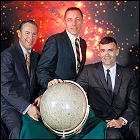 The third planned lunar landing mission, Apollo 13, lifts off. Astronauts Jim Lovell and Fred Haise are scheduled to walk in the Fra Mauro region of the moon. Command module pilot Ken Mattingly falls victim to a medical condition, leaving NASA to make a rare substitution, rotating the backup crew’s command module pilot, Jack Swigert, to the prime crew prior to launch.
The third planned lunar landing mission, Apollo 13, lifts off. Astronauts Jim Lovell and Fred Haise are scheduled to walk in the Fra Mauro region of the moon. Command module pilot Ken Mattingly falls victim to a medical condition, leaving NASA to make a rare substitution, rotating the backup crew’s command module pilot, Jack Swigert, to the prime crew prior to launch.
This mission is dramatized in both the We Interrupt This Mission episode of HBO’s 1998 series From The Earth To The Moon, as well as the 1995 movie Apollo 13.
Hear about it on the Sci-Fi 5 podcast

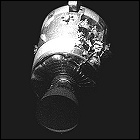 Halfway between Earth and the moon, a fuel cell rupture in the Apollo 13 service module causes a massive explosion. The crew has to activate the landing module, Aquarius, to use it as a “lifeboat”; the oxygen and power reserves of the command module, Odyssey, have been compromised by the explosion and must be preserved for re-entry. The crew endures extreme cold and must ration consumables to survive. Fortunately, there’s enough fuel in Aquarius’ descent stage to put the combined vehicle on a free-return trajectory, looping it around the far side of the moon for an immediate return to Earth.
Halfway between Earth and the moon, a fuel cell rupture in the Apollo 13 service module causes a massive explosion. The crew has to activate the landing module, Aquarius, to use it as a “lifeboat”; the oxygen and power reserves of the command module, Odyssey, have been compromised by the explosion and must be preserved for re-entry. The crew endures extreme cold and must ration consumables to survive. Fortunately, there’s enough fuel in Aquarius’ descent stage to put the combined vehicle on a free-return trajectory, looping it around the far side of the moon for an immediate return to Earth.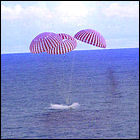 Having become the stuff of round-the-clock news coverage (though few media outlets bothered to cover any aspects of the mission before the emergency took place), the reactivated Apollo 13 command module Odyssey successfully reenters Earth’s atmosphere and returns its crew safely. (The lunar module, Aquarius, has been discarded in Earth orbit, where it eventually disintegrates, upon reentry; rather than landing on the moon, its fuel and air reserves have served the much more important function of keeping the crew alive.)
Having become the stuff of round-the-clock news coverage (though few media outlets bothered to cover any aspects of the mission before the emergency took place), the reactivated Apollo 13 command module Odyssey successfully reenters Earth’s atmosphere and returns its crew safely. (The lunar module, Aquarius, has been discarded in Earth orbit, where it eventually disintegrates, upon reentry; rather than landing on the moon, its fuel and air reserves have served the much more important function of keeping the crew alive.)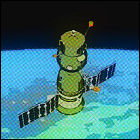 The Soviet Union launches Soyuz 9, a long-endurance mission which becomes the longest space flight in human history to date, lasting 18 days. Biomedical measurements are taken of cosmonauts Andrian Nikolayev and Vitaly Sevastyanov throughout their two-and-a-half-week stay in orbit, and Soyuz 9 is seen as a trailblazer for the Soviet space program’s new focus of long-term crewed space stations. Both cosmonauts suffer from muscle loss during their flight, as the Soyuz capsule isn’t big enough to allow for exercise.
The Soviet Union launches Soyuz 9, a long-endurance mission which becomes the longest space flight in human history to date, lasting 18 days. Biomedical measurements are taken of cosmonauts Andrian Nikolayev and Vitaly Sevastyanov throughout their two-and-a-half-week stay in orbit, and Soyuz 9 is seen as a trailblazer for the Soviet space program’s new focus of long-term crewed space stations. Both cosmonauts suffer from muscle loss during their flight, as the Soyuz capsule isn’t big enough to allow for exercise.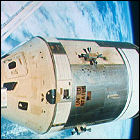 After the Congressional budget for the fiscal year of
After the Congressional budget for the fiscal year of 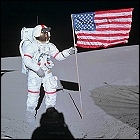 After nearly a year of examining the problems that nearly doomed the crew of Apollo 13, the third lunar landing is achieved by the crew of
After nearly a year of examining the problems that nearly doomed the crew of Apollo 13, the third lunar landing is achieved by the crew of 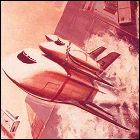 Potential contractors for NASA’s upcoming Space Shuttle offer specs based on their final design studies, which still assume that the shuttle’s giant booster will be a manned, winged vehicle in its own right that will return to a runway on Earth after its fuel is used up. One thing that both studies suggest, however, is an aluminum airframe which requires a shift away from the ablative metallic heat shields of the Mercury, Gemini and Apollo programs. A system of carbon-reinforced “shingles” is suggested as an alternative, and is approved by NASA, though developing the technology to create, install and maintain these tiles delays the first Shuttle launch into the 1980s, and the tiles are still prone to damage during both launch and re-entry – a weakness that will eventually seal the end of the Space Shuttle era.
Potential contractors for NASA’s upcoming Space Shuttle offer specs based on their final design studies, which still assume that the shuttle’s giant booster will be a manned, winged vehicle in its own right that will return to a runway on Earth after its fuel is used up. One thing that both studies suggest, however, is an aluminum airframe which requires a shift away from the ablative metallic heat shields of the Mercury, Gemini and Apollo programs. A system of carbon-reinforced “shingles” is suggested as an alternative, and is approved by NASA, though developing the technology to create, install and maintain these tiles delays the first Shuttle launch into the 1980s, and the tiles are still prone to damage during both launch and re-entry – a weakness that will eventually seal the end of the Space Shuttle era.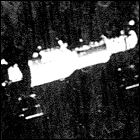 Salyut 1, the first orbiting space station in history is launched, unmanned, by the Soviet Union. With Salyut 1, the Soviet space program intends to vault ahead of the United States in a new space discipline (namely long stays in space and the study of human endurance in a zero-G environment), having lost the moon race. The first Salyut station will orbit Earth for less than a year.
Salyut 1, the first orbiting space station in history is launched, unmanned, by the Soviet Union. With Salyut 1, the Soviet space program intends to vault ahead of the United States in a new space discipline (namely long stays in space and the study of human endurance in a zero-G environment), having lost the moon race. The first Salyut station will orbit Earth for less than a year.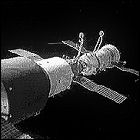 The Soviet Union launches the Soyuz 10 mission, intended to become the first crew to occupy an Earth-orbiting space station. Flying a new modification of the Soyuz vehicle, fitted with a new system for docking to the Salyut 1 space station, are Vladimir Shatalov, Alexei Yeliseyev and Nikolai Rukavishnikov, but they won’t be the first space station crew in history: the Soyuz capsule fails to hard-dock to the station, making it impossible for them to enter. Soyuz 10 returns to Earth after two days, and even on the return journey the cosmonauts are sickened by toxic fumes in their environmental system. Salyut 1 remains in orbit, still unmanned.
The Soviet Union launches the Soyuz 10 mission, intended to become the first crew to occupy an Earth-orbiting space station. Flying a new modification of the Soyuz vehicle, fitted with a new system for docking to the Salyut 1 space station, are Vladimir Shatalov, Alexei Yeliseyev and Nikolai Rukavishnikov, but they won’t be the first space station crew in history: the Soyuz capsule fails to hard-dock to the station, making it impossible for them to enter. Soyuz 10 returns to Earth after two days, and even on the return journey the cosmonauts are sickened by toxic fumes in their environmental system. Salyut 1 remains in orbit, still unmanned.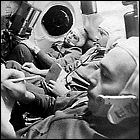 After a tuberculosis scare forces Soviet space officials to ground the mission’s original crew, the backup crew of Soyuz 11 lifts off to become the first occupants of a manned space station. Experiencing none of the difficulties that plagued the earlier Soyuz 10 attempt to dock with Salyut 1, the Soyuz 11 crew stays aboard Salyut for 22 days, a new record for a manned space mission.
After a tuberculosis scare forces Soviet space officials to ground the mission’s original crew, the backup crew of Soyuz 11 lifts off to become the first occupants of a manned space station. Experiencing none of the difficulties that plagued the earlier Soyuz 10 attempt to dock with Salyut 1, the Soyuz 11 crew stays aboard Salyut for 22 days, a new record for a manned space mission.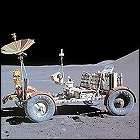 The Apollo 15 mission lifts off, carrying astronauts David Scott, James Irwin and Al Worden on a 12-day mission to the moon and back. Aboard the lunar module Falcon, Scott and Irwin become, respectively, the seventh and eighth men to walk on the moon, exploring the mountainous Hadley Rille region, while Worden pilots the command/service module Endeavour. The service module for this mission is equipped with a suite of sensors and instruments designed to be exposed to space in lunar orbit. Scott and Irwin become the first men to drive on the moon, covering over seven miles in the first lunar rover “moon buggy.”
The Apollo 15 mission lifts off, carrying astronauts David Scott, James Irwin and Al Worden on a 12-day mission to the moon and back. Aboard the lunar module Falcon, Scott and Irwin become, respectively, the seventh and eighth men to walk on the moon, exploring the mountainous Hadley Rille region, while Worden pilots the command/service module Endeavour. The service module for this mission is equipped with a suite of sensors and instruments designed to be exposed to space in lunar orbit. Scott and Irwin become the first men to drive on the moon, covering over seven miles in the first lunar rover “moon buggy.”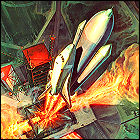 President Richard Nixon announces that, after three years of studies, design concepts, and deliberations, he has given NASA the go-ahead to develop a reusable space vehicle, the Space Shuttle, which can perform multiple mission profiles, land safely and launch again, with the eventual goal of launching a shuttle almost every week of the year. The contract to build the shuttle is awarded to Apollo command/service module contractor North American Aviation, which is later to complete a merger with Rockwell International, which assumes the task of building the shuttles. The first launch date is projected to take place at some point in the mid-to-late 1970s.
President Richard Nixon announces that, after three years of studies, design concepts, and deliberations, he has given NASA the go-ahead to develop a reusable space vehicle, the Space Shuttle, which can perform multiple mission profiles, land safely and launch again, with the eventual goal of launching a shuttle almost every week of the year. The contract to build the shuttle is awarded to Apollo command/service module contractor North American Aviation, which is later to complete a merger with Rockwell International, which assumes the task of building the shuttles. The first launch date is projected to take place at some point in the mid-to-late 1970s.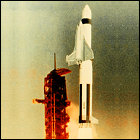 After a five-month design study focusing on alternatives to a winged (and manned) reusable first stage bosoter for the upcoming Space Shuttle, NASA settles on a configuration consisting of two solid rocket boosters strapped to the shuttle’s external fuel tank. Among the alternatives considered was the possibility of restarting production of the Saturn V rockets that launched Apollo and Skylab missions, with the shuttle and its fuel tank separating from the Saturn V’s first stage at high altitude (though in this configuration, a failure of the shuttle’s main engines would prove to be catastrophic). The SRB/tank configuration is expected to shave half a billion dollars off of the shuttle’s development costs.
After a five-month design study focusing on alternatives to a winged (and manned) reusable first stage bosoter for the upcoming Space Shuttle, NASA settles on a configuration consisting of two solid rocket boosters strapped to the shuttle’s external fuel tank. Among the alternatives considered was the possibility of restarting production of the Saturn V rockets that launched Apollo and Skylab missions, with the shuttle and its fuel tank separating from the Saturn V’s first stage at high altitude (though in this configuration, a failure of the shuttle’s main engines would prove to be catastrophic). The SRB/tank configuration is expected to shave half a billion dollars off of the shuttle’s development costs.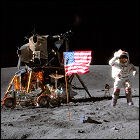 NASA launches the Apollo 16 mission to the moon, lasting 11 days total. Astronauts John Young and Charlie Duke descend to the lunar surface in the lander Orion, while Ken Mattingly pilots the command/service module Casper in orbit. Again, a lunar rover is tucked into one side of the lunar module, allowing Young and Duke to reach distances of 16 miles from their landing site. They spend a total of 20 hours walking on the moon’s surface, collecting over 200 pounds of soil and rock samples from the Descartes highlands region.
NASA launches the Apollo 16 mission to the moon, lasting 11 days total. Astronauts John Young and Charlie Duke descend to the lunar surface in the lander Orion, while Ken Mattingly pilots the command/service module Casper in orbit. Again, a lunar rover is tucked into one side of the lunar module, allowing Young and Duke to reach distances of 16 miles from their landing site. They spend a total of 20 hours walking on the moon’s surface, collecting over 200 pounds of soil and rock samples from the Descartes highlands region.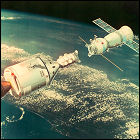 After two years of hammering out details and wording, President Nixon and Soviet Premier Alexei Kosygin sign an international agreement to share science and technology between the United States and Soviet Union, including an agreement to mount a joint space mission culminating in the docking of an Apollo spacecraft and a Soyuz spacecraft in Earth orbit in
After two years of hammering out details and wording, President Nixon and Soviet Premier Alexei Kosygin sign an international agreement to share science and technology between the United States and Soviet Union, including an agreement to mount a joint space mission culminating in the docking of an Apollo spacecraft and a Soyuz spacecraft in Earth orbit in 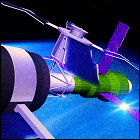 With planning already well underway for the Apollo-Soyuz mission which won’t take place until
With planning already well underway for the Apollo-Soyuz mission which won’t take place until 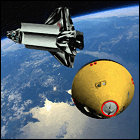 Space shuttle contractor North American Rockwell submits a safety study to NASA concerning safety and escape systems for the upcoming space shuttle, including a study of smaller vehicles with potential use as “lifeboats” in the event that a shuttle is unfit for return to Earth due to heat shield or other catastrophic damage. The various proposals, which include the possibility of permanently berthing an Apollo command module (another vehicle contracted to North American Rockwell) in the shuttle’s cargo bay for use as a lifeboat, are rejected by NASA due to the impact that each proposal would have on available space and weight for cargo.
Space shuttle contractor North American Rockwell submits a safety study to NASA concerning safety and escape systems for the upcoming space shuttle, including a study of smaller vehicles with potential use as “lifeboats” in the event that a shuttle is unfit for return to Earth due to heat shield or other catastrophic damage. The various proposals, which include the possibility of permanently berthing an Apollo command module (another vehicle contracted to North American Rockwell) in the shuttle’s cargo bay for use as a lifeboat, are rejected by NASA due to the impact that each proposal would have on available space and weight for cargo.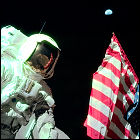 The final manned lunar landing mission lifts off atop a Saturn V rocket. Apollo 17 is the first mission to include a qualified geologist, Harrison Schmitt, in its crew; Gene Cernan and Schmitt descend to the surface aboard the lunar lander Challenger, where the last two men to walk on the moon spend a total of 22 hours exploring the Taurus-Littrow valley. For the third mission in a row, a lunar rover is stowed into one side of the lander. Astronaut Ron Evans orbits overhead in the command/service module America. The astronauts return on December 19th, bringing home nearly 250 pounds of lunar soil and rock samples.
The final manned lunar landing mission lifts off atop a Saturn V rocket. Apollo 17 is the first mission to include a qualified geologist, Harrison Schmitt, in its crew; Gene Cernan and Schmitt descend to the surface aboard the lunar lander Challenger, where the last two men to walk on the moon spend a total of 22 hours exploring the Taurus-Littrow valley. For the third mission in a row, a lunar rover is stowed into one side of the lander. Astronaut Ron Evans orbits overhead in the command/service module America. The astronauts return on December 19th, bringing home nearly 250 pounds of lunar soil and rock samples.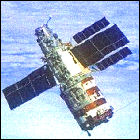 The Soviet Union launches a second space station, and the first station designed exclusively for military tasks in orbit. Salyut 2 is the first station to use the Almaz military space station design devised in the 1960s as a response to the US Air Force’s never-flown Manned Orbiting Laboratory. Within two weeks, however, technical difficulties take their toll: Salyut 2 begins to tumble out of control, and its crew compartment depressurizes. (The redesigned Soyuz vehicle is not ready to fly yet, so no crew ever visits Salyut 2.) The second Soviet space station burns up in the atmosphere less than two months after launch.
The Soviet Union launches a second space station, and the first station designed exclusively for military tasks in orbit. Salyut 2 is the first station to use the Almaz military space station design devised in the 1960s as a response to the US Air Force’s never-flown Manned Orbiting Laboratory. Within two weeks, however, technical difficulties take their toll: Salyut 2 begins to tumble out of control, and its crew compartment depressurizes. (The redesigned Soyuz vehicle is not ready to fly yet, so no crew ever visits Salyut 2.) The second Soviet space station burns up in the atmosphere less than two months after launch.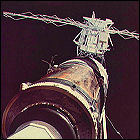 The first American space station,
The first American space station, 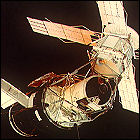 The first three-man Skylab crew lifts off to undertake a mission far different from the one for which they had trained. Their primary objective is now to save the crippled station from the damage it suffered during launch; as it is, Skylab is uninhabitable, with temperatures in its workshop and crew quarters soaring above 100 degrees, threatening to heat up items inside enough to fill the space with toxic gases. The first repair spacewalk takes place less than 24 hours after the crew arrives in an Apollo capsule, and succeeds in starting to drop the temperature inside.
The first three-man Skylab crew lifts off to undertake a mission far different from the one for which they had trained. Their primary objective is now to save the crippled station from the damage it suffered during launch; as it is, Skylab is uninhabitable, with temperatures in its workshop and crew quarters soaring above 100 degrees, threatening to heat up items inside enough to fill the space with toxic gases. The first repair spacewalk takes place less than 24 hours after the crew arrives in an Apollo capsule, and succeeds in starting to drop the temperature inside.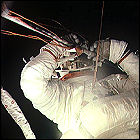 Two members of
Two members of 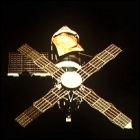 Having repaired and secured the damaged Skylab over the course of three spacewalks, the space station’s first three-man crew leaves the station and returns to Earth after 28 days in space, experiencing gravity after nearly a month of zero-G.
Having repaired and secured the damaged Skylab over the course of three spacewalks, the space station’s first three-man crew leaves the station and returns to Earth after 28 days in space, experiencing gravity after nearly a month of zero-G.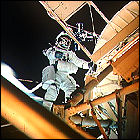 With the first Skylab crew having salvaged the first American space station, the second crew – designated Skylab 3 – lifts off for another long-term stay in space. Alan Bean, Jack Lousma and Owen Garriott spend 59 days aboard Skylab, performing a spacewalk to conduct further repairs to their damaged space station, investigating the effects of long-duration weightlessness and space travel on the human body, and observing the sun through Skylab’s solar telescope system. A thruster leak in the Apollo command/service module forces NASA to consider a rescue mission.
With the first Skylab crew having salvaged the first American space station, the second crew – designated Skylab 3 – lifts off for another long-term stay in space. Alan Bean, Jack Lousma and Owen Garriott spend 59 days aboard Skylab, performing a spacewalk to conduct further repairs to their damaged space station, investigating the effects of long-duration weightlessness and space travel on the human body, and observing the sun through Skylab’s solar telescope system. A thruster leak in the Apollo command/service module forces NASA to consider a rescue mission.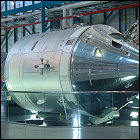 A thruster leak in the Skylab 3 crew’s Apollo command/service module forces NASA to consider a Skylab Rescue mission using a modified five-seater Apollo vehicle, mounted atop a Saturn IB and rolled out to the pad in readiness for the emergency flight. NASA brings in enough engineers and employees to have shifts working around the clock, seven days a week, to get the emergency mission ready for launch on September 9th. The thruster issue is later resolved, and the first-ever planned space rescue mission stands down. Astronauts Vance Brand and Don Lind are assigned to the rescue mission; both men later flew the Space Shuttle, though Brand will also fly in the Apollo-Soyuz Test Project. The modified command/service module and Saturn rocket are retained in case a rescue is needed for the final Skylab flight, and then as an Apollo-Soyuz backup vehicle, before being retired and displayed at the Smithsonian and Kennedy Space Center.
A thruster leak in the Skylab 3 crew’s Apollo command/service module forces NASA to consider a Skylab Rescue mission using a modified five-seater Apollo vehicle, mounted atop a Saturn IB and rolled out to the pad in readiness for the emergency flight. NASA brings in enough engineers and employees to have shifts working around the clock, seven days a week, to get the emergency mission ready for launch on September 9th. The thruster issue is later resolved, and the first-ever planned space rescue mission stands down. Astronauts Vance Brand and Don Lind are assigned to the rescue mission; both men later flew the Space Shuttle, though Brand will also fly in the Apollo-Soyuz Test Project. The modified command/service module and Saturn rocket are retained in case a rescue is needed for the final Skylab flight, and then as an Apollo-Soyuz backup vehicle, before being retired and displayed at the Smithsonian and Kennedy Space Center.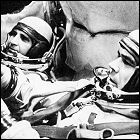 After two years of reorganization and rethinking, the Soviet manned space program resumes with the launch of Soyuz 12, carrying cosmonauts Vasili Lazarev and Oleg Makarov. Previously a three-seater, Soyuz has been redesigned following the Soyuz 11 tragedy: the vehicle now seats a crew of two, both wearing fully pressurized spacesuits. Originally intended to visit the Salyut 2 station, Soyuz 12 is only a two-day shakedown flight for the redesigned spacecraft (Salyut 2’s own technical problems have rendered it uninhabitable by a human crew).
After two years of reorganization and rethinking, the Soviet manned space program resumes with the launch of Soyuz 12, carrying cosmonauts Vasili Lazarev and Oleg Makarov. Previously a three-seater, Soyuz has been redesigned following the Soyuz 11 tragedy: the vehicle now seats a crew of two, both wearing fully pressurized spacesuits. Originally intended to visit the Salyut 2 station, Soyuz 12 is only a two-day shakedown flight for the redesigned spacecraft (Salyut 2’s own technical problems have rendered it uninhabitable by a human crew).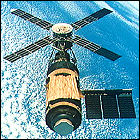 The third and final crew of the first American space station, Skylab 4, lifts off for an 84-day stay. The crew’s tasks include medical and biological experiments, solar observations (including the first space-based recording of solar flare origination), and observations of Comet Kohoutek. Crewmembers Gerald Carr, William Pogue and Edward Gibson have a frank discussion with ground controllers about their extremely busy work schedule (similar to heated discussions between Apollo 7’s crew and Houston) halfway through the nearly-three-month mission. Skylab is left powered down, but still habitable, at the end of the crew’s stay, in anticipation that future Space Shuttle crews will someday occupy Skylab.
The third and final crew of the first American space station, Skylab 4, lifts off for an 84-day stay. The crew’s tasks include medical and biological experiments, solar observations (including the first space-based recording of solar flare origination), and observations of Comet Kohoutek. Crewmembers Gerald Carr, William Pogue and Edward Gibson have a frank discussion with ground controllers about their extremely busy work schedule (similar to heated discussions between Apollo 7’s crew and Houston) halfway through the nearly-three-month mission. Skylab is left powered down, but still habitable, at the end of the crew’s stay, in anticipation that future Space Shuttle crews will someday occupy Skylab.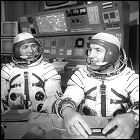 Cosmonauts Pyotr Klimuk and Valentin Lebedev lift off aboard Soyuz 13, the second proving flight of the redesigned Soyuz spacecraft. Their eight-day-long stay in Earth orbit is a Soviet space program rarity: a flight devoted solely to scientific observations with no military objectives. Many of the science experiments were originally intended to be conducted on board the Salyut 1 space station. Much like the Skylab 4 crew, which is in orbit at the same time, the Soyuz 13 crew is able to observe Comet Kohoutek.
Cosmonauts Pyotr Klimuk and Valentin Lebedev lift off aboard Soyuz 13, the second proving flight of the redesigned Soyuz spacecraft. Their eight-day-long stay in Earth orbit is a Soviet space program rarity: a flight devoted solely to scientific observations with no military objectives. Many of the science experiments were originally intended to be conducted on board the Salyut 1 space station. Much like the Skylab 4 crew, which is in orbit at the same time, the Soyuz 13 crew is able to observe Comet Kohoutek.